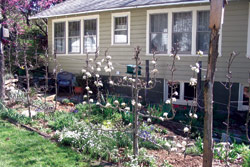I’ve always had a fascination with plants that have been manipulated by man. At one time in my life, I had a collection of at least 25 shallowly rooted plants, procured in the wild and at nurseries and chosen as the most grotesque and malformed specimens I could find for bonsai culture.

But after several years of nurturing them, I lost the collection when I went adventuring for a summer and left them in the care of a pal who didn’t appreciate the daily attention required. The universe clearly signaled that I wasn’t cut out for bonsai stewardship.
Still, I had my eye on related arts.
In the 1920s, an anthropologist interviewing elderly Comanches in north Texas learned that the natural springs found across the southern Great Plains were marked by trees pruned to a main stem and tied to the ground. Thus trained, the trees pointed exactly toward the next spring, sometimes many miles away.
An even older tradition is the art of the espalier, a French term for training shrubs and trees to a variety of forms, usually flat against a wall. If you look closely at woodcuts, drawings or paintings of any medieval European garden, you’ll often see fruit trees growing up a wall, branching out sideways. That’s an espalier.
This relentless manipulation of apple, pear, peach, plum, nectarine and cherry trees has practical purposes. Strict pruning results in fewer but better quality fruit. Growth against walls offers protection against late-spring frosts, and in olden times, it allowed forcing—installing seasonal glass covers to make the tree produce early fruit. The two-dimensional growth also allows the gardener to more readily see any potential diseases and insect damage, long before such problems get out of control. And you can grow several trees where otherwise there’s room for only one spreading tree.
But there’s one more benefit: Espaliers create a wicked aesthetic. On the edge of a patio I’ve visited in southern New England, a 40-year-old pear tree goes straight up for 10 feet and then fans out horizontally for 20 feet (it’s attached to 2-inch-diameter rusted iron plumbing pipes for support). In addition to creating a shaded outside living space, the overall effect is stunning and elegant. And the tree produces quality food, too. How cool is that?
My north Asheville gardening pals Jenny and Robbie Sweetser have five espaliers (three apples and two pears) trained on wires along their property line. They planted the trees 12 years ago as 1-year-old saplings that Jenny pruned to 18 inches each, which allowed for selecting two new horizontal branches and a new vertical stem. For the third growing season, that vertical shoot was trimmed again at 18 inches with a new vertical and two new horizontal shoots. This method was duplicated for the fourth season, resulting in the very precise branching seen in classic espalier. It takes about eight years to achieve any appreciable fruit production, but it looks awesome.
At our old place up north, I espaliered a pair of Japanese pears on a wooden fence. The trees produced several seasons of great pears before we moved south. And you’d think I would have planted at least a couple of espaliers in the 14 years I’ve been steward of Jardin Fou down here, but I haven’t. But this year, I swore it would be different.
Thanks to a gardening pal at Reems Creek Nursery, I brought home a 3-year-old dwarf variety of ‘Liberty’ apple tree. It had a strong central stem and good lateral branching well-suited for an informal, rambling espalier style. I also chose ‘Liberty’ because I wanted a good pie apple and because the savvy nursery folks claim it has excellent disease resistance.
On the south-facing side of a tall shed at my driveway’s edge, I dug a hole twice the size of the pot the apple tree came in. I imagined it five years from now, growing gracefully across the face of the 14-foot-tall shed, trained branches framing quaint garden art hung on the weathered-wood wall and strategically shading tastefully painted, old-time, double-hung windows. The branches would be covered with breathtaking fruit. Visiting friends would marvel at my pleaching prowess, and I would have to admit, “Yes, I am quite the espalier man.”
But then it rained, and the water refused to percolate through the hard clay at the bottom of the hole. Between rains, the water didn’t drop an inch in three days of hot weather. So now I don’t feel so cocky about my potential as an espalier man. I’m trying to understand that my well-laid fantasies need revision, and I’m looking at my property carefully, because an espalier takes long-term commitment.
[Jeff Ashton gardens in Weaverville.]



Before you comment
The comments section is here to provide a platform for civil dialogue on the issues we face together as a local community. Xpress is committed to offering this platform for all voices, but when the tone of the discussion gets nasty or strays off topic, we believe many people choose not to participate. Xpress editors are determined to moderate comments to ensure a constructive interchange is maintained. All comments judged not to be in keeping with the spirit of civil discourse will be removed and repeat violators will be banned. See here for our terms of service. Thank you for being part of this effort to promote respectful discussion.